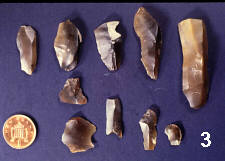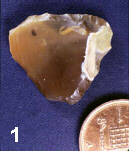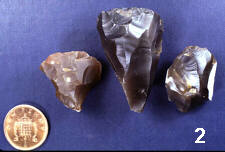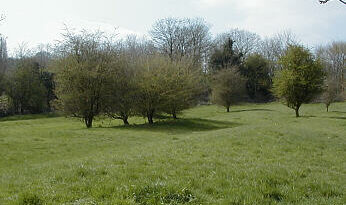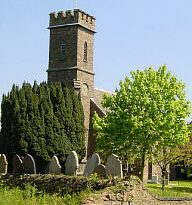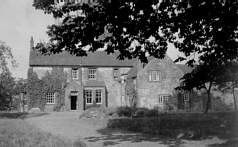Meet the Flintstones
In the 1980s Groby Archaeology Society were active in the parish, systematically fieldwalking over the ploughed land (with the farmer’s permission, of course) to look for signs of human occupation or activity. By far the oldest evidence that we found was a scatter of worked flints, which turned up near Martinshaw Wood in 1983. I can well remember the excitement of picking up these items from the soil, realising that they have probably not been touched by anyone since the Stone Age!
Flint is a silica-rich rock which naturally forms rounded nodules with a chalky outer coating or cortex. Complete or broken nodules are commonly found in the clay soils of the English Midlands. When a nodule is broken, a lustrous grey inner surface is revealed, similar to glass but not quite as shiny. The broken edges can be very sharp, a property that did not escape the notice of Stone Age man. He “worked” the natural flints into artefacts – knives, scrapers, arrowheads and so on. They can be found more or less as they were abandoned, thousands of years ago.
Some styles of flint arrowheads are easily recognised as such, but most flint artefacts look (to the untrained eye) hardly any different from natural fragments. After all, many of the worked flints spotted by fieldwalkers are surely the waste pieces chipped off in the process of making the actual tool. The final product may well have been taken away to be used or traded.
When flint nodules break naturally, the fracture surface is flat or gently curved, smooth but dull. But when a flint is struck hard (which is unlikely to occur in nature) then it breaks in a different way. The shape of the fracture surface is shaped like the shell of a mussel, strongly curved near the point of impact (called the “bulb of percussion”) but more gently curved away from that point. The fracture surface is often rippled, with a glassy finish. These features are difficult to describe and illustrate, so they are best learned by handling worked flints that have been identified by experts.
- Scraper, possibly used for preparing animal hide.
- Three cores, the middle one showing well the striking platform at the top. The core on the right shows ripples in some of the fracture surfaces.
- A variety of flakes. The blade on the right shows secondary working – tiny flakes taken off the edge.
To obtain long, blade-shaped pieces, a flint knapper would first remove the cortex then fashion a flat surface known as a “striking platform”. Then a series of blows around the edge of the striking platform would cause long, “flakes” to detach from the “core”, leaving parallel flake scars. The Groby finds include a number of cores and flakes. Some flakes have been further worked by removing tiny flakes from their edges.
After examination by archaeologists at the Jewry Wall Museum, Leicester, the style of working was identified as Mesolithic, that’s the Middle Stone Age, 10,000 – 3,500 bc. The lifestyle of Mesolithic people was hunting and gathering. They had no agricultural land that tied them to one place, so they moved around according to the season. Perhaps the people who made these flints were following the migration of large herbivorous animals through the forest, and had camped here for a few days. Travelling light was a necessity, so I cannot imagine them carrying many stone tools around with them. Knowing that natural flint was easily found in stream and river beds, they would surely have made tools on the spot when required. Perhaps a successful hunting party had paused here to prepare tools for scraping clean and cutting up a deer hide.
This collection of flints, about 60 in total, is at the Jewry Wall Museum, St Nicholas Circle, Leicester.
For further information on flint knapping see http://museums.ncl.ac.uk/flint/knap.html

